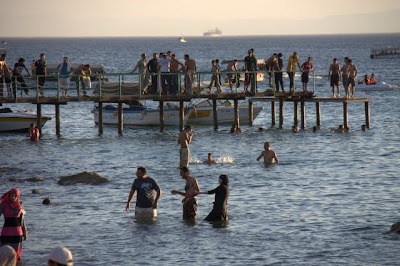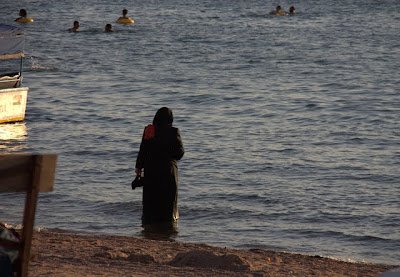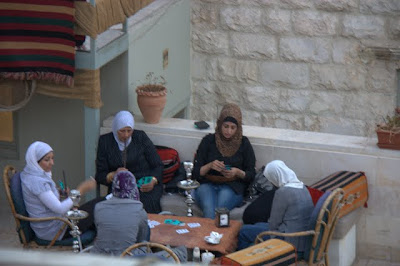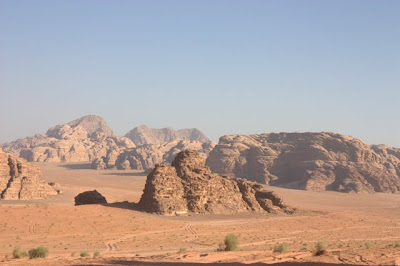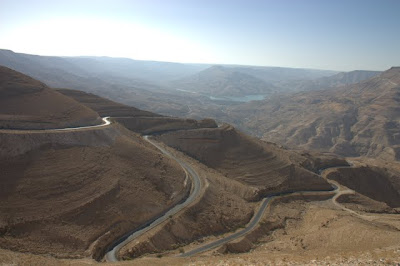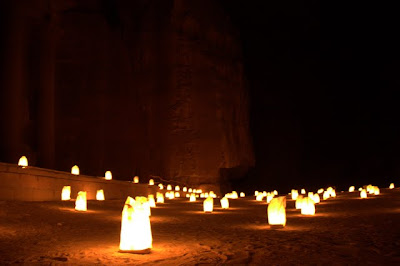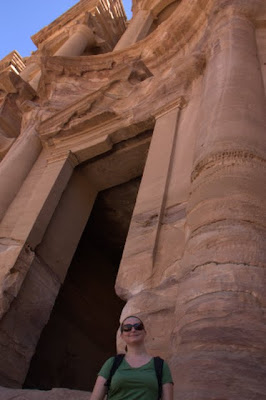Jordan Beyond the Sites
Going to Jordan was Sean’s pick; to be honest, I felt very little enthusiasm towards travelling there. I mostly wanted to get it over with to get on to the Asia part of our trip. But as things usually turn out on this trip, even if I couldn’t say it was always fun to travel there, it certainly was fascinating.
I knew very little about Jordan before we travelled there. I knew it is in the Middle East; it is mainly Muslim; and they have a very pretty Queen (who I once saw on 60 Minutes).
Looking at Jordan on a map, it doesn’t seem like it is very safe place to travel. It shares borders with Israel, Palestine, Syria, Saudi Arabia, and Iraq. Despite its position in an area of turmoil, Jordan has managed to maintain good relations with both its Middle Eastern neighbors and the Western world. Jordan’s permissive policies towards accepting Palestinian and Iraqi refugees have left it struggling to figure out how to bear the burden of the additional people it let inside its borders. There are actually more Palestinians living in Jordan than native Jordanians.
Although Islam is the country’s official religion, Jordan is tolerant of other religions and generally keeps religion and government at arm’s length. Jordan has one of the largest Christian populations in the Middle East. Most of the Christians live in Madaba, a small city just south of Amman that we visited for a few days. We arrived in Jordan during the tail end of Ramadan, a Muslim holiday that involves fasting between sunup and sundown for a month. It is one of those holidays that never have a set date, so we asked the owner of the hotel we were staying at in Madaba when Ramadan was ending. Um, I don’t know, I’m not sure when it finishes. Hmm, I thought to myself, is he a heathen or something? How does he not know when it ends? After rifling through the calendar, he responded, Yeah, I think they finish celebrating on Thursday. After a pause, he continued, I’m Christian, so I get to eat, drink and smoke whatever I want! I felt ashamed for automatically assuming he was Muslim just because he spoke Arabic and was from a Middle Eastern country. The first of many lessons I learned during our 10 days in Jordan.
Like many developing countries, Jordan has the usual frustrations and curiosities: busses that do not leave until they are completely full; cities that look like they are either perpetually unfinished or falling apart due to empty lots filled with crumbling rubble, giant holes in any paved surface, and steel rebar sticking up from buildings; an ever-present layer of dust and litter; constant exhaust fumes filling the air; and accommodations that make you cringe if you look too closely. Noticeably absent were aggressive people looking to make a buck at your expense. Unlike Morocco, no one hassled us, no one followed us, no one tried to scam us.
Noticeably present, however, were the differences in the way that men and women are treated. Jordan does have a more liberal attitude towards women, but more liberal is relative, of course, to the Muslim countries that don’t give women any rights. I was never uncomfortable travelling through Jordan, but certain things stood out to me. I refrained from wearing my shorts, dress or tank-top for the most part, and do not consider my v-neck shirts to be particularly low-cut, but I could feel eyes gravitating toward what little skin I showed and often chose to wear a scarf around my neck just to avoid any extra attention. Time and time again, we were warmly greeted by Jordanians, with a welcome, welcome. But sometimes, it seemed I was more welcome than Sean, because the phrase and their eyes would be directed at me as if Sean wasn’t there.
Early on in our trip, a well-travelled Jordanian man told us that he was embarrassed by the way that Jordanian men acted because they didn’t know how to act around women. Other than the porn display in the desert, we saw this most clearly when we went snorkeling in the Red Sea. Taking a break from snorkeling, we watched all of eyes of the Jordanian guys sitting under the shelter near us follow a French girl wearing a bikini walk to the shelter from the water. While the rest of them stared, one of them struck up a conversation with her. You have great skin, one of them said, never removing his eyes from her. Um, thanks, she mumbled. Need help with your suntan lotion? The whole scene was awkward, to say the least.
I was curious what exactly people wore to the beach in a country where most of the women still wore at least a head covering. I wouldn’t get my answer at this beach, which was located outside the city close to a cluster of dive centers. At the public beaches close to downtown Aqaba, however, women went in the sea with the same attire they wore on land, while the men wore swim trunks or perhaps a sleeveless t-shirt as well.
Perhaps this is why it struck me as odd, later, when a woman who was essentially covered from head-to-toe pulled out her breast to breast-feed her child on a public bus. Her child was wailing at the top of his lungs, and everyone on the bus – mostly men – glared in disapproval. I took a chance and turned around in my seat to play peek-a-boo with the child. His cries turned to laughter. The woman smiled at me, and I smiled back. A few minutes later, when I turned around again, I noticed her breastfeeding. Perhaps Jordan views this activity as something that is necessary for a child’s well-being – I see that they have breast-feeding laws protecting working mothers – but this didn’t seem to mesh with the sight of woman after woman completely covered up, some head to toe.
I know the women’s dress in Muslim countries is a complicated subject, and I don’t even present to understand the intricacies behind wardrobe decisions. It was continually jarring for me to see how much most women covered up even in a supposedly liberal country like Jordan.
For its small size, Jordan has lots of interesting and beautiful sites. But even beyond the sites, it is a fascinating country with a distinctly Middle-Eastern culture. In the end, I was glad we made a foray into the Middle East and got to know Jordan more than we did at the beginning.
Low Point on Our Trip
Well, in Jordan, we finally reached the low point on our trip. Actually, we reached the lowest point on earth that we’ll ever go: the Dead Sea. The Dead Sea touches Jordan and Israel not too far away from Amman and Madaba. Not only is the lowest point on earth, it also has four times the salt content of any ocean, making it impossible not to immediately float once you hit the water.
We hired what was supposed to be a budget driver from our budget hotel to take us to the Dead Sea and back to Madaba, but by the time you add in the cost of the driver and the 15 JOD admission fee to the tourist beach they take you to, it was quite a costly morning. There are supposedly public areas you can visit, but our driver acted like he had never heard of that.
We didn’t stay in the water long, because it was a challenge to avoid getting the super salty water in your mouth, and it stung my sensitive skin. But it was fun being buoyant for a while. And people – especially those trying to sell you the Dead Sea products – believe the minerals in the water have health benefits, so why not go for a swim?
Naturally, it is obligatory for every traveler who goes to Jordan to make the trip to the Dead Sea and take a photo bobbing around in the water. I think it must be a condition of getting your Jordanian visa, or something, so who were we to argue?
Tom and Jerry, Sun-lit Scenery, and Porn: Just Another Trip to the Desert
You may recall in Morocco, we rode camels into the Sahara Desert and stayed overnight in a Berber camp. You may also recall that we were glad we went, but said, and I quote, that there is “not a chance” that we would ever go back into the desert again. Famous last words.
Into the Desert We Go….Again
One of the main attractions in Jordan is Wadi Rum, a desert area in the southern part of the country where Lawrence of Arabia was filmed. In addition to the sites from the movie, the desert is renowned for its interesting rock formations rising up from the sand. At first we planned to skip seeing Wadi Rum. But the more that Sean read about it, the more he wanted to go. So somehow he talked me into seeing the desert again.
We both agreed on one thing: no camels this time. Ideally, we wanted to just take a jeep tour for the day, but when we read that public transportation in and out of Wadi Rum is a bit difficult to find, especially for a round trip on the same day, we decided we would spend the night. (As it turns out, there were others on the bus to Wadi Rum that were just planning on being there for the day, so it obviously can be done).
The only bus from Wadi Musa to Wadi Rum that we could find left Wadi Musa at the ungodly hour of 6:30, so we found ourselves in the desert at 8:00 a.m. with plenty of time on our hands. We had reserved two spots at a well-rated camp run by a Bedouin family the night before. Nail, the son of the mysterious Obied, a man we heard much about and even talked to on the phone but never saw in person, picked us up in his fancy new Toyota truck (a.k.a. our “Jeep”). I’m not sure exactly how old Nail is, but I would wager that he is in his early twenties. Nail appeared to be on the vain side. To our continual amusement, he kept checking himself out in the rearview mirror and fiddling with his head scarf to make sure it was perfect. Even though we were in the desert and no one was around, except us.
A Typical Saturday Morning
When we got to the camp, we were the only guests there. We looked at each other. Now what? It was only 8:30 a.m.
We sat around for a while, and around 9:30, Nail asked us if we wanted to come with him to run a few errands in his village, which was just outside the Wadi Rum protected area. Not having anything better to do, and not wanted to sit around and swelter in the desert all day, we agreed. First we got gas. Next we picked up vegetables for dinner in a shack covered with crates of vegetables. Finally, we dropped off some of the vegetables at Nail’s family’s home. All of this took quite some time, because Nail appeared to know everyone in the village.
At Nail’s family’s home, we were invited into the living room. Although I was dying to, I didn’t take any pictures while we were there because it felt intrusive. The room was bare except for a carpet, a couch lining the room that essentially was cushions on the floor and propped up on the walls, and a television. We ended up hanging out there for a couple of hours. Nail kept asking us if we wanted to go, but we both were relishing the opportunity to see how a family lived in a small desert town.
Nail’s little brother and sister – around 7 and 8 – sat watching cartoons on the television. Tom and Jerry was on most of the time, which is a favorite of our friends’ son. In between watching television, the little boy and girl hung out with us. We played with legos and play-doh. The little girl played some game with me that I suspected she had made up, which involved putting little bits of Kleenex in your hands and the crooks of your elbows in a certain order that I was never able to master. Sean played match after match of checkers with another of Nail’s brothers, who was in his teens.
Meanwhile, women came and went. Even though we were there, some of the women who had entered wearing a full face covering removed them once in Nail’s parents’ home. It was obvious that family ties were important, based on the presence of extended family, the way Nail spoke about his family, and their closeness in their home. In the privacy of the home, Nail’s mother sat and hugged her children, including Nail. In the background, in the kitchen, a tween-age girl, presumably another sister, hurried around performing domestic duties enrobed in a head scarf. No matter how many times I saw women with the full head scarves or face coverings, I still could not get used to it. I could not wrap my mind around the fact that the adorable little girl in pigtails, a pink shirt and jeans would someday soon need to cover her head or her face from the world. If it wasn’t for the womens’ dress and roles, the whole scene could have taken place on any Saturday morning, almost anywhere in the world.
Except it wasn’t anywhere in the world. It was in Jordan, and it was September 11. The news at home, I had read the day before, was running stories about the outrage certain people felt about the proposed placement of a Muslim mosque near the former site of the World Trade Center. How ridiculous, I had thought. Yet the whole time I was watching Tom and Jerry, I couldn’t get over how surreal the whole thing felt. Back in 2001, I never would have guessed that 9 years later, I would be spending the anniversary of that horrible day in a Middle-Eastern, predominantly Muslim country, sitting in a Bedouin family’s living room, watching cartoons and playing games with Jordanian children.
Cruising Around the Desert
In the late afternoon, after we left Nail’s house and ate lunch, we took our “Jeep” tour, complete with super-authentic air conditioning and super-loud Arabic pop music blasting. It felt wrong to not be experiencing the desert in the open air, but then I remembered that I hate sand and wind and decided to embrace the music as a soundtrack to our desert exploration. We bounced and flew along the sand for three hours, viewing the rock formations in the late afternoon sun and some of the famous landmarks. The reddish sand dunes in the Sahara in Morocco were impressive, but the rocky scenery in Wadi Rum was quite amazing.

The one who is not a fan of heights at the top; I stayed at the bottom to photograph. Not because I was scared, no siree! (Actually, it was because I wanted to spare the other tourists the spectacle of my klutzy self scrambling up the rock in my flip flops).
Bow-Chicka-Bow-Wow
Later that night, we were joined for dinner by two other guests (hello, Diana!), Nail’s friends, more brothers, and his uncle.
The guests had to leave right after dinner, leaving Sean and I sitting around the campfire with our Bedouin hosts. Our hosts smoked flavored tobacco from the shisha and we drank tea, a.k.a. Bedouin whiskey (suspiciously similar to Berber whiskey we had in the Sahara) while being told how wonderful it was that we were experiencing Bedouin culture in the silence of the desert under the stars. After tea, I didn’t feel like talking, and laid my head down, silently lamenting my inability to see such stars, once again, due to all of the bright lights around the campsite and wondering what silence they were talking about, since their cell phones were constantly going off and they alternated playing Arabic music from Nail’s truck or through the tinny speakers of their phones. Suddenly, Sean asked me, in a strange voice, if I was ready to go to bed. Once we were in our tent, I found out why he was ready to turn in so suddenly. Unbeknowngst to me, Nail’s uncle was looking at pornographic movies on his cell phone, and felt the need to show them to Sean not once, not twice, but three times, with commentary like, Nice, huh? or Check this out. Sean had nodded politely, but then he escaped since he had no interest in sitting around the desert with a group of men watching tiny pornographic movies on a cell phone. I was shocked that the uncle would show Sean these images, especially with me right next to him.
This strange event capped off a very surreal day. The porn screening was at odds with the family-centered atmosphere we observed earlier, and was in interesting juxtaposition to the covered women and strict rules of Jordanian Muslim society.
Early morning sunrise
We rose early the next morning to watch the sun rise and to hightail it to Aqaba for a proper shower and snorkeling as soon as possible. In Morocco, the sunset was the highlight of the desert experience. This time, it was the sunrise (definitely not the awkward porn screening!)
It was interesting how the Berber and Bedouin cultures are so similarly marketed to tourists, yet reality does not always live up to the advertising. Nevertheless, as it turned out, our second trip to the desert was even more memorable to than the first. What we experienced on September 11, 2010 may not be the authentic Bedouin cultural experience they market at the tour center, but for better or worse, we did get to see how some of today’s Bedouins live.
Riding Down King’s Highway
I’ll admit it; the main reason I wanted to take the long way from Madaba to Wadi Musa down the King’s Highway was because King’s Highway is one of my most favorite songs. I’m pretty sure one has nothing to do with another, officially, but unofficially, they are linked in my mind. This was a song I listened to quite frequently when daydreaming about the trip, long before I even knew there was a King’s Highway in Jordan or that I’d someday ride down it.
When the time gets right
I’m gonna pick you up
And take you far way from trouble my love
Under a big ol’ sky
Out in a field of green
There’s gotta be something left for us to believeOh, I await the day
Good fortune comes our way
And we ride down the Kings HighwayNo you can’t hide out
In a six gun town
We wanna hold our heads up, but we gotta stay down
I don’t wanna end up
In a room all alone
Don’t wanna end up someone that I don’t even knowLover, I await the day
Good fortune comes our way
And we ride down the Kings Highway– King’s Highway, Tom Petty
Sean and Amy Do Petra.
One of our main reasons for visiting Jordan – really, everyone’s main reason for visiting Jordan – was to go to Petra. Petra is an ancient city carved into red-rose rock. It was established sometime around 6 B.C. by the Nabatean people. Petra is a UNESCO World Heritage Site and one of the New Seven Wonders of the World. Visiting Petra, like much of Jordan, was totally Sean’s thing and not mine, but it turned out to be pretty cool.
The most famous building, and the first one you see upon entrance, is the Treasury. You may remember the Treasury from the Indiana Jones and the Last Crusade; it is the building holding the Holy Grail at the end of the movie. (Which we know is a fiction, because we saw the Holy Grail in the Cathedral in Valencia!)
Before you get to see the Treasury, you first have to walk about a mile back into the city flanked on either side by towering red rock formations. We caught our first sight of the Treasury by candlelight. On our first night, we joined a couple hundred people in the tour back to the Treasury. The candlelight gave enough light only to give a sense of the towering rocks surrounding us.
The next morning, we woke up early and ventured in again. This time, we could see just how large the rocks lining the path are.
You walk, and walk, and walk, and finally, through a crack in the rocks, you get the big reveal. In between the rock formations, you see a hint of the Treasury peeking through.
It isn’t until you get all the way through the rock formation path, however, that you truly can take stock of the Treasury and all of its grandeur. It is a huge building, as you can tell from this picture of me standing in front of it. It is carved into the rock with such detail that you can hardly believe that humans could have done this, by hand.
Besides the Treasury, there are other buildings and things carved into the stones, such as the amphitheatre and tombs. Sean convinced me to engage in one of my least favorite activities – walking up steps. Over 800 steps, to be more precise. You could hire hand-led donkeys to take you up the narrow steep pathway, but if I was going to fall off this mountain, I was going to do it on my own accord.
The destination was Petra’s second grandest building, the Monastery, which was located at the top of a steep hillside. As I trudged up the hill, soaked with sweat, with the morning sun now beating down without relief, I was reminded of my failure to “summit” a similar hillside in the heat in Morocco. This time, I was determined to make it to the top. We kept seeing the same two elderly women chugging along. Although I felt pathetic to use their progress as a benchmark, I was pleased that at the very least, we beat them to the top, where the Monastery stands just as tall and grand as the Treasury.
Although the buildings are what earned Petra its acclaim, the rocks themselves fascinated me just as much. Their red-rosy glow earned Petra the nickname of the Red Rose City. In certain areas, the rosey rocks swirl into beautiful blues and purples. It is gorgeous.
If you go: We stayed at the Sun Set Hotel, a no-frills budget hotel with wifi in the lobby within walking distance to restaurants and Petra. It was nice not to have to rely on transport to get to Petra, and it allowed us to get up early to see Petra before it got too crowded and before the sun got too hot. We spent 2 nights in Wadi Musa, and thought 6 or 7 hours was enough to see everything we wanted to see. If you are interested in seeing everything in Petra, you will want to allot at least two days. When they say that you will do a lot of walking, they are not lying – you will do A LOT of walking. And it will be hot. Water is readily available to replenish your supply in Petra, even at the top of the mountain with the Monastery. You will need it. Be prepared for the sticker shock of Petra’s price. It is now 33 Jordanian dinars – about $46 USD. In November, it is going up to a shocking 50 JD – about $70.60 USD. Not too long ago, it was only 15 JD/21 USD. Petra is definitely a special place that deserves to be visited, and I am sure that there are continuing research and archaeological costs, but paying $70 to get in seems extreme. What is extra frustrating about the price increases is that it does not seem like any of the money is going back in to improve the attraction for the tourists that support it. Most of the few bathrooms inside are basically porta-potties, and many of the paths are not in good repair. I don’t expect Petra to be in perfect condition, considering it is an ancient city, but I expect some basic improvements if I am paying $50 or $70 for something that formerly cost $21.
